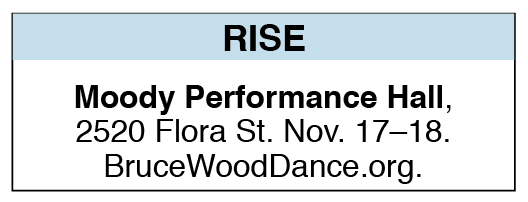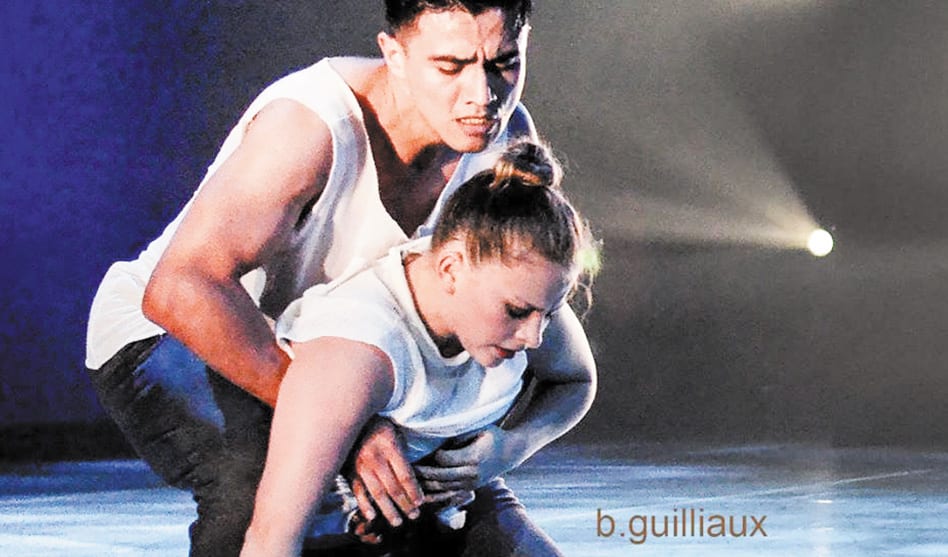Nestor Perez met Bruce Wood only once, but the impact has informed his dedication to dance. (Photo courtesy Brian Guilliaux)
3 years after its namesake’s death, Bruce Wood Dance thrives in all-new ways
ARNOLD WAYNE JONES | Executive Editor
jones@dallasvoice.com
 It is a few weeks before Rise, the new performance from Bruce Wood Dance is set to open, and the company’s producer, Gayle Halperin, is hosting one of her salons. Held before each show, it previews the works that will be presented and gets longtime patrons, recent donors and some newcomers a peek into the creative process. But this time, as she gives her usual pitch, she chokes up. Bruce Wood — the company’s founder and artistic director — died suddenly more than three years ago, and the pain of that loss still stings. But Halperin also realizes something while glancing at the current company: Not including the creative team, none of the dancers ever worked directly with Wood himself.
It is a few weeks before Rise, the new performance from Bruce Wood Dance is set to open, and the company’s producer, Gayle Halperin, is hosting one of her salons. Held before each show, it previews the works that will be presented and gets longtime patrons, recent donors and some newcomers a peek into the creative process. But this time, as she gives her usual pitch, she chokes up. Bruce Wood — the company’s founder and artistic director — died suddenly more than three years ago, and the pain of that loss still stings. But Halperin also realizes something while glancing at the current company: Not including the creative team, none of the dancers ever worked directly with Wood himself.
That resonates not only with Halperin, but with all those present. It’s a realization just how far the troupe has come against impossible odds.
Bruce Wood was already an established and respected dancer, choreographer and company founder when Halperin approached him, in 2010, to do “a project” — bring his talents back to North Texas stages for a recital. Initially, it was just going to be a one-off, but the success of it triggered an itch both had to scratch. The Bruce Wood Dance Project was born, and it completed three seasons before Wood succumbed to complications from AIDS just weeks before the start of its fourth season. Halperin and the remaining dancers soldiered on through that production, and decided to see if they could maintain it. Kimi Nikaidoh, who had danced with the defunct Bruce Wood Dance Company during its stint in Fort Worth, was tapped as artistic director; Wood protégés Joy Bollinger and Albert Drake were given leadership positions. And the company grew.
And grew. Earlier this year, the word “project” was officially dropped — it was no longer a temporary enterprise, but a going concern in the artistic tapestry of North Texas. In addition to the two annual concerts, the company performs in festivals and with groups like the Turtle Creek Chorale. But growth also meant some dancers — who tend to have a finite career span anyway — moved on. And on this day last month, it occurred to Halperin that almost everyone dancing under the banner of “Bruce Wood” had never even met the man.
One sort-of exception was Nestor Leonardo Perez. His experience with Wood — which he told at the salon — was met with hushed respect. Perez began studying dance when he attended Texas Woman’s University in Denton in 2009. When he graduated, he auditioned in front of Wood… but was passed over for inclusion in the company at that time. But it didn’t end there.
Wood took him aside, Perez explained, and put his hand on his shoulder to give him advice and support. He encouraged the young man to keep at it. After Wood passed, Perez auditioned again; he is now in his third year as an apprentice with the company.
“Where I come from was very horrible,” Perez, a native of the southern tropical region of Mexico, explained at the salon. “I was not accepted for who I was.” Wood was an inspiration and guiding light; not entering the company on his first audition wasn’t an impediment but a challenge to succeed. (For her part, Halperin expressed amazement at Perez’s accomplishments and dedication.)
Two of the dances to be performed at Rise — The Only Way Through Is Through (originally from 1998) and Lay Your Burdens Down (performed only once before, and now making its Dallas debut) — were original Wood works; the third is a world premiere, Hillside, created by Bollinger, who cannot help but be influenced by her mentor. The pieces themselves continue Wood’s legacy, but it’s in the dedication and commitment of dancers who never worked with Wood that his spirit remains.











